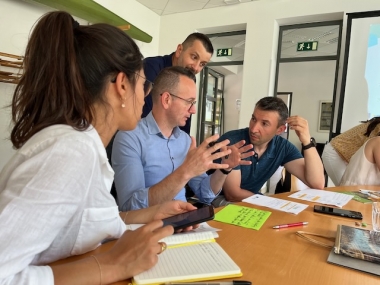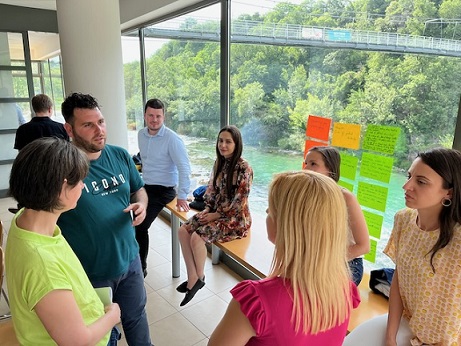Managing conflicts for improving city spaces and mobility systems: lessons from the experience of Thriving Streets
Edited on
18 August 2022Simone d’Antonio, Ad-hoc expert Thriving Streets
A review of tools and techniques that European cities and the partners of Thriving Streets are using for reducing conflicts in their local communities to make urban spaces and mobility systems more inclusive and accessible for all. The topic was at the core of a thematic session in the framework of the transnational meeting of Nova Gorica: here some of the most interesting elements emerged from the debate among the cities

"It's not my duty as Mayor to make sure you have a parking spot. It's the same as if you bought a cow, or a fridge, then ask me where you're going to put them”. The famous sentence pronounced by the Mayor of Pontevedra Miguel Anxo Fernández Lores is very incisive in explaining the vision that lays behind the political choice of banning cars from most of the city since 1999. However, even in cities where the plans for pedestrianization are not so drastic as in Pontevedra, the management of potential conflicts with different categories of users can be particularly challenging for local authorities.
Interventions on public spaces, such as the regeneration of a square or the reduction of parking spots available in favour of different uses of the street space, usually implicate potential forms of opposition, which can be managed with different strategies and techniques.
In the recent history of European urbanism preventing protests by the residents through the systematic organization of public meetings and assemblies, in which problems can be discussed and solved, was considered a decisive part of the success of bold plans and initiatives. The assemblies organized by the former Mayor of Barcelona Pasqual Maragall in the different neighbourhoods of the city to explain the impact and the legacy of the regeneration action carried out in view of the 1992 Olympic Games are still considered a reference model for huge processes of urban transformation. However, even though local authorities are often committed to managing smaller plans, the basic elements of Barcelona’s model of dialogue and civic engagement are still valid and replicable elsewhere.
Tools and techniques for reducing conflicts
The use of communication tools and the organization of public gatherings and assemblies for informing people on urban changes and debating the most controversial aspects is considered a crucial element for making residents decisive actors in the process. Channels such as social media pages of the Mayors or institutional Instagram accounts can be unexpectedly useful not only for collecting criticism but also for orientating the discussion towards concrete solutions and for inviting people to be part of the civic engagement mechanisms. The active involvement of key actors in the local public debate, such as thematic influencers or civic testimonials (such as the artists involved in Amsterdam in the creation of night policies, or even appointed as Night Mayors) can be crucial for scaling up the quality and the visibility of the discussion, raising the perception of its importance by the residents.
The establishment of a true community-led process, in which the opinion of residents, groups and NGOs count and is legitimated by the process itself, is fundamental when public spaces and mobility systems are redesigned, and different needs have to be considered. The use of gamification tools in many cities around the world contributed to smoothing out a conflict before it arose, fostering the community spirit in a playful way, and promoting fair access to digital tools and technologies (such as computer games as Minecraft, used for making urban design more accessible to different categories of users).
At the basis of these processes, there is often a collaborative rediscovering of neighbourhoods and places at the core of the intervention through walkabouts and other forms of urban exploration. The potential of initiatives such as Jane’s Walks organized in many cities around the world following the experience of the American urban theorist Jane Jacobs is still largely unexplored but can be the basis for fostering collaborative ownership of the public space, and reducing conflicts about its management through the launch of schemes emerged from direct observation on the field.
The active involvement of different city departments in this kind of process can be useful for enhancing the collaboration between those who curate city planning and who oversee public participation or communication, but also for tearing down thematic silos and reducing potential disagreement within the local authority in terms of strategies to be followed. A strong political leadership often is not enough, if not paired with the capacity of civic officials of dealing with the everyday challenges emerging from the ground, translating the diverging needs into shared answers to the problems.

How Thriving streets partners are managing conflicts in an efficient way
The definition of ambitious Integrated Action Plans and the implementation of Small-Scale Actions are interesting grounds for action and reflection on innovative uses of city spaces and mobility infrastructure and services for improving the quality of life. In both cases, the active involvement of local stakeholders and community representatives fostered the dialogue on innovative solutions but also on issues left unsolved or undecided.
The development of new parking policies, the expansion of pedestrian areas, and the creation of new green areas instead of parking spots are just some examples of the measures discussed in the framework of the URBACT Local Groups in cities such as Santo Tirso, Igoumenitsa, Oradea and Debrecen, which are combining the mediation among conflicting interests with the development of technical solutions for solving some of the most pressing issues from short to long term.
The development of participatory schemes is fostering collaboration among different city departments and is raising the attention of the residents on the importance of reusing public spaces with mixed-uses or temporary actions to be consolidated also thanks to powerful political support. The active involvement of categories that are more critical to the action of the local authority, such as business owners or groups of residents in which the actions of regeneration are taking place, is proving to be decisive also for collecting relevant inputs going beyond the boundaries of the project. The collaborative schemes are suggesting interesting measures for improving public transport systems, introducing new strategies for sustainable parking, or reducing the speed of circulating vehicles: the comparison with similar strategies carried out by European and global cities has offered useful benchmark elements, but also the belief that change is possible if the challenges related to public space and transportation are managed in an innovative, participatory way.

Submitted by Francesca Blamonti on
